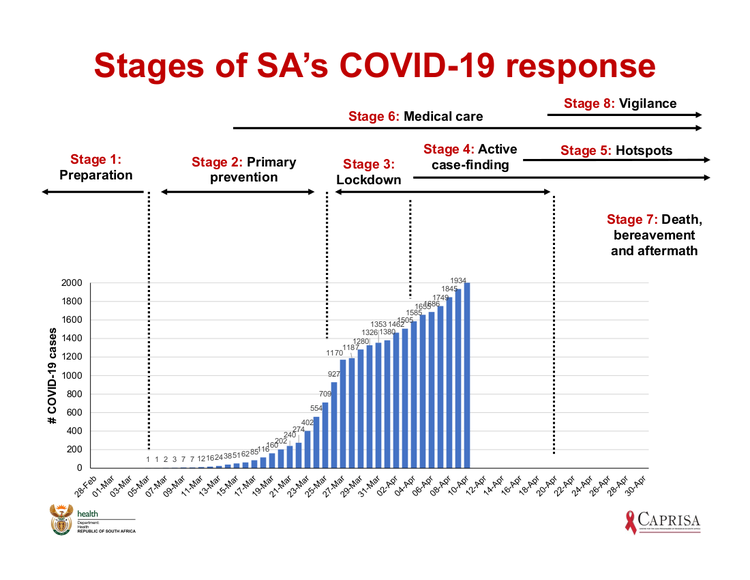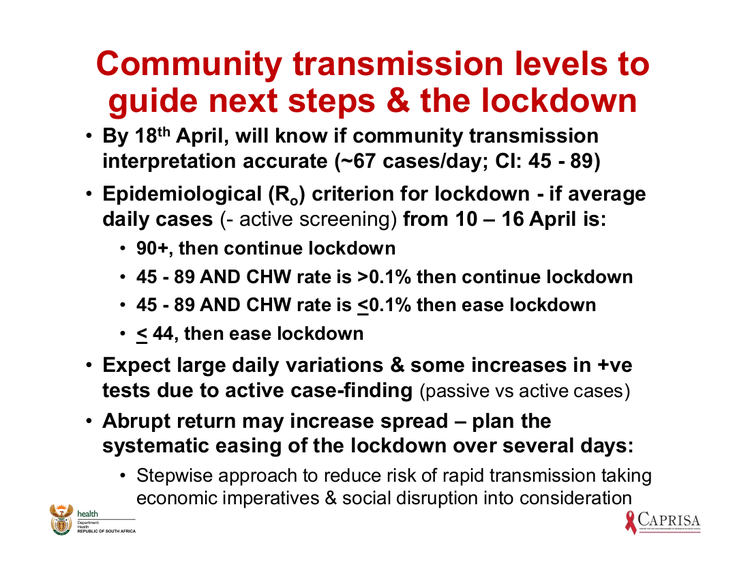Covid-19: The unanswered questions after Minister Mkhize’s team’s excellent presentations
With great overview, comes great responsibility
The wide ranging Covid-19 briefing hosted by Health Minister Zweli Mkhize has cracked open the sphere of technical and political deliberation about “The Covid Response” in many ways.
The minister spoke with humanity about the latest deaths, on which he is clearly fully briefed.
It was also good to see him decline to hog the floor, allowing key subject experts to bring their experience and knowledge to the table. The main presentation, given by Professor Salim Abdool-Karim (a renowned HIV researcher and former president of the SA Medical Research Council), gave clear evidence of the pragmatic, deep and multi-layered planning discussions that have been going on for weeks.
Stages of the epidemic were presented in intuitive graphics, showing imported cases, early transmissions, and the dreaded community spread, with reflection on (problematic) data from nominal case counts and (so far, absent) signs of health system strain.
Questions were answered on delays between infection and case reporting, the shifting of the meaning of case data as testing criteria evolve, the nuances of mask use, and the strong age-dependence of severity of Covid disease.
There was a sensible balance between fear of the inevitable worsening of the situation and hopeful indications that an early conflagration has been avoided. There was even space for fine detail such as the point made by modelling expert Brian Williams, that contact tracing, our main real tool besides social distancing, is more efficient than intuitively expected because it naturally follows the infection routes to the main hubs – the so called super-spreaders.
There was a lot of detail to digest, and a welcome opportunity to engage – ending with the closing promise that unfielded questions would still be addressed by the Department of Health.
There is a key gap in the presentation though. It contains, on page 24, criteria for whether the lockdown is eased or not. If the average daily cases from 10 to 16 April is 90 or more the lockdown will continue. If it’s below 44 the lockdown will be eased. If there are 44 to 90 daily cases, the slide on page 24 is unclear but it appears to depend on the proportion of positive results among tests performed by the community health workers.
Page 24 from the presentation by Professor Abdool Karim
Besides the calculations behind this decision being unclear, no substance is provided about the range of options between full lockdown and no lockdown. This is a discussion that very much needs to take place.
On Monday, the DA released the outline of a multi-staged plan, which, while probably not something to be adopted as offered, is an important stab at a crucial framework that must somehow be assembled.
In his presentation Professor Abdool-Karim only hinted at this. He noted that a lockdown could be “eased” rather than lifted “abruptly” and that easing might take time. How much time? According to the presentation, it will be merely “several days” .
Yet I fear we already all know that the easing of the lockdown will take not days but months; more months, perhaps, than we can count on our fingers. What will replace the hard phase? How will we meld regulation with grassroots creativity? And crucially – how will this gradual difficult adjustment be monitored and course corrections be implemented? The criteria floated on page 24 of the presentation, based on average daily case counts and test positivity rates, cannot seriously be regarded as some kind of actual monitoring and evaluation framework – though Professor Abdool-Karim’s voiceover did at least assure us a plan is taking shape.
It would be unfair to demand, at this point, final decisions which are clearly very difficult, and will take time to shake out. But adapting infection control measures to shifting reality, as reflected in imperfect data, is the ultimate lever which we as a society have, if we wish to turn the next few months into a time of action rather than a time of waiting.
There are many suggestions for easing the lockdown that may not substantially increase the risk of new infections. Besides the DA document, South Africans have put forward numerous suggestions in open letters and in their social media discussions. Cabinet will need to take these suggestions seriously in weeks to come if the infection control measures are to maintain their legitimacy.
Having seen the presentation on Monday night, I think we can take heart, and continue to press for further open discussion.
Views expressed are not necessarily GroundUp’s.
Support independent journalism
Donate using Payfast

Don't miss out on the latest news
We respect your privacy, and promise we won't spam you.
Next: Covid-19: Roads blocked, rocks thrown during food protest in Cape Town
Previous: Covid-19: The Strandfontein Relocation Camp is a test of our morality as a city
© 2020 GroundUp.
This article is licensed under a Creative Commons Attribution-NoDerivatives 4.0 International License.
You may republish this article, so long as you credit the authors and GroundUp, and do not change the text. Please include a link back to the original article.


